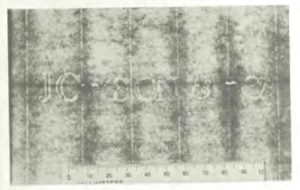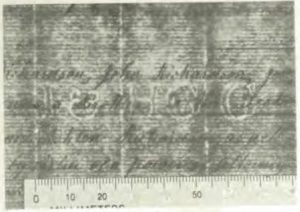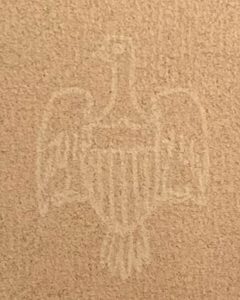EARLY YORKLYN PAPER
Ten years after the American Revolution, two New Castle County grist milling families found they could not compete with the larger milling operations of the immediate area. Joshua and Thomas Gilpin in 1787 converted their family grist mill on the Brandywine to the manufacture of paper. The Gilpins would go on to revolutionize the papermaking industry by designing, constructing, and patenting the first machine to automatically make paper in America in 1817. In a short period of time, America dethroned England as the world’s papermaker when American production outpaced England’s.
The other papermaking family was a resident of then Auburn, now Yorklyn. In 1789 this family converted their grist mill to the manufacture of paper. What was their name? Hint: If you are thinking it is the Marshall family, the Marshalls didn’t construct their first grist mill in Pennsylvania until 1770, just before the American Revolution. Paper would not be made in the Marshall Homestead Mill until 1856.
Answer
Buying land in Leticia Manor in 1726, John (1) Garrett and his family settled along the both banks of Red Clay Creek to farm the rich soil and study the characteristics of the creek. In 1730 John (1) entered into partnership with four neighbors building a grist mill (mill #1) on 10 acres of his land on the west side of the creek in Mill Creek Hundred. Operational in 1731, the mill was making the partners a nice profit ten years later. John (1) withdrew from the partnership and continued farming the land he owned adjacent to #1 grist mill. Eventually, #1 grist mill and the 10 acres of land surrounding the mill, were sold by the partners.
John (1) constructed another grist mill (#2), perhaps larger, downstream of the original #1 mill but on the eastern banks of the Red Clay Creek in Christiana Hundred. John’s (1) two sons, Thomas (by his first wife) and John (2) (by his second wife) inherited the land and #2 grist mill upon John (1) passing in 1757.
Thomas Garrett moved to Prince William County Virginia in the early 1760s having inherited 620 acres from his father John (1). John’s (1) son John (2) remained in Delaware having inherited the family farm, home, and #2 grist m ill to continue milling operations. Within a short time, John (2) repurchases the original 10-acre milling site and #1 mill that his father had constructed forty years prior. After serving as an officer during the Revolution, John (2) returns to farming and milling. In 1782 John (2) constructs another mill on the Red Clay and begins milling tobacco. By 1789, John (2) Garrett reaches the conclusion that his grist milling operations can’t compete with Lea family’s mills on the Brandywine and decides to focus on snuff manufacture. John (2) attempts a sale of the grist milling operations. When no buyers surface, he decides the #1 mill shall be converted to papermaking while the #2 mill will now produce snuff.
ill to continue milling operations. Within a short time, John (2) repurchases the original 10-acre milling site and #1 mill that his father had constructed forty years prior. After serving as an officer during the Revolution, John (2) returns to farming and milling. In 1782 John (2) constructs another mill on the Red Clay and begins milling tobacco. By 1789, John (2) Garrett reaches the conclusion that his grist milling operations can’t compete with Lea family’s mills on the Brandywine and decides to focus on snuff manufacture. John (2) attempts a sale of the grist milling operations. When no buyers surface, he decides the #1 mill shall be converted to papermaking while the #2 mill will now produce snuff.
Local Garrett interest in papermaking started with both John (2), and his sons John (3), and Horatio Gates Garrett. Journals of the Nathan Sellers Company of Philadelphia indicate John (2) Garrett purchased the first watermarks for papermaking screens held within a handheld deckle in 1797. There are examples of Garrett watermarked paper, made at Yorklyn (see photos), in or around 1795. Additional watermarks for Yorklyn were purchased in 1799 and 1800.
 Historians believe Garrett began to produce cotton rag paper in the early 1790’s. A paper mold watermarked “J G SON & CO” was ordered on December 10, 1799 from Sellers. The quality must have been excellent as another with the same watermark was ordered on January 20, 1800. The watermark “J & H G CO” along with an eagle figure have been identified on letters dated 1801, indicating Horatio and his brother John (3) had joined the firm. In 1804 Horatio took over full control of the papermaking operation after John (3) moves to Ohio. John (2) was in declining health and would pass away a few years later.
Historians believe Garrett began to produce cotton rag paper in the early 1790’s. A paper mold watermarked “J G SON & CO” was ordered on December 10, 1799 from Sellers. The quality must have been excellent as another with the same watermark was ordered on January 20, 1800. The watermark “J & H G CO” along with an eagle figure have been identified on letters dated 1801, indicating Horatio and his brother John (3) had joined the firm. In 1804 Horatio took over full control of the papermaking operation after John (3) moves to Ohio. John (2) was in declining health and would pass away a few years later.
 Horatio ordered additional papermaking molds from Sellers in October 1805. A papermaking mold watermarked ”H G G” was ordered on May 5, 1810. Horatio eventually faced severe financial problems with the mill and finally advertised it for sale beginning in January 1812. The mill was sold under court order in March 1813. Horatio moved to Steubenville, Ohio, where he managed another paper mill. He died in 1832.
Horatio ordered additional papermaking molds from Sellers in October 1805. A papermaking mold watermarked ”H G G” was ordered on May 5, 1810. Horatio eventually faced severe financial problems with the mill and finally advertised it for sale beginning in January 1812. The mill was sold under court order in March 1813. Horatio moved to Steubenville, Ohio, where he managed another paper mill. He died in 1832.

